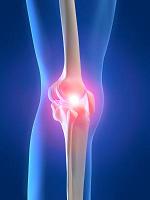Bioactive Nanofibers Regenerate Cartilage, Save Your Joints

Share
As we age, we expect to spend our golden years playing with grandchildren, traveling the world, or taking up exciting new hobbies. However, our bodies do not always keep up with our plans and one area where this is quite evident is joint health. Loss of cartilage is a common ailment in the older population and countless attempts have been made to figure out a way to regenerate healthy new cartilage. Where many have failed, Dr. Samuel Stupp and colleagues at Northwestern University may have succeeded. In a recent article in the journal PNAS, the researchers provide details of the first treatment that allows efficient regeneration of cartilage without the need for surgery. Using self-assembling bioactive nanofibers, they have seen dramatic results with an animal model. It looks like Grandma may just be able to get her groove back! Check out the video below for an interview with Dr. Stupp and the many applications for their regenerative system.
According to the Department of Orthopedic Surgery and Sports Medicine at the University of Washington School of Medicine, degenerative joint disease “probably affects almost every person over age 60 to some degree, but symptoms are often mild.” Degenerative joint disease (commonly referred to as osteoarthritis) is characterized by the loss of cartilage, the flexible cushion in joints that allows movement without bone-to-bone contact. After enough cartilage has been lost, sufferers are left to deal with various symptoms including stiffness, tenderness and joint pain. Currently, treatments for this common ailment include physical therapy, weight loss to ease the burden on joints and a regimen of non-steroidal anti-inflammatory drugs (NSAIDs) to treat pain and inflammation. Surgical joint replacement is also an option, though usually reserved for advanced or severe cases. It’s clear that all of the treatments described above address the symptoms of osteoarthritis, rather than the cause. This is because cartilage does not naturally regenerate after damage like other types of tissue and scientists have been unable to find a way to get it to do so. That is, until this exciting new advancement.
The basis for the treatment developed by Dr. Stupp’s laboratory is a class of molecules called peptide amphiphiles (PAs). These molecules are made partly from the body's own basic building blocks, proteins and lipids. Under the right conditions, these molecules will self-assemble into nanofibers and form a gelatinous matrix. What really makes this system outstanding is that after self-assembly, the material is designed to bind to key molecules in the body, known as growth factors. Growth factors are molecular signals that stimulate cells to grow and divide. Therefore, the nanofibers will allow the concentration of growth factors in the exact area where the cartilage needs to grow, stimulating stem cells to form new, healthy cartilage! To demonstrate the potential and varying applications of these nanofibers, Dr. Stupp’s group designed them to bind to different molecules in the body. In those experiments, the nanofibers were injected into mice with severe spinal cord injuries. After a few weeks, some of the animals were able to regain use of their limbs after the nanofibers stimulated the regrowth of nerves in the injured spinal cord!
One of the most important considerations with any medical treatment that introduces foreign materials into the body is how well that material is tolerated. A critical component of this system is that after some time, the nanofibers will dissolve and be recycled by the body, since they are made of molecules (proteins and lipids) that the body naturally uses. So far, Dr. Stupp’s group has shown this system to be quite effective in rabbit and mouse animal models and while that is an important first step, it may be some time before we see the use of this system in humans. The next step will be to test the nanofibers in larger animal models. If they can demonstrate efficacy and safety in these models, then clinical trials would begin testing of the system in humans.
Be Part of the Future
Sign up to receive top stories about groundbreaking technologies and visionary thinkers from SingularityHub.


Extending the lifespan of human beings is an area of intense research in biomedical science today. However, increased longevity is worthless if it is spent bedridden and/or in pain. The work of Dr. Stupp and colleagues is therefore important because although it does not increase a person’s lifespan, it will surely increase the quality of life. Further, the other potential applications for self-assembling nanofibers are wide open. It is conceivable that in the near future, this revolutionary system may become a common medical procedure for adults heading into their golden years, similar to the prevalence of Lasik eye surgery to correct another common failing of our bodies. The future is looking bright indeed!
Image credit: istockphoto/sebastian kaulitzki
[Sources: The Stupp Laboratory, Northwestern University, PNAS, National Institute of Biomedical Imaging and Bioengineering]
Related Articles

New Gene Drive Stops the Spread of Malaria—Without Killing Any Mosquitoes

These Robots Are the Size of Single Cells and Cost Just a Penny Apiece

Hugging Face Says AI Models With Reasoning Use 30x More Energy on Average
What we’re reading
